| Content | Rupert Neve Designs' Shelford Channel, over a half century in the making, is the definitive evolution of Mr. Neve's renowned 80 Series channel module technology, updated and refined for the contemporary studio. The Shelford Channel is fitted with Rupert's latest Class A transformer-gain mic preamp, the best-of-the-classics Inductor EQ from the Shelford 5052, a punchy diode-bridge compressor, the alluring analog textures of variable Silk saturation, a state-of-the-art dual-tap transformer output stage with massive headroom, and double the operating voltage of vintage designs. Offering rich tonal options for making audacious statements with your music, along with precision-detented controls for recall, the Shelford Channel delivers the authoritative sonic essence of classic Rupert Neve designs, along with modern versatility.
Input stage and transformer-gain mic pre
Rupert Neve's first new Class A, transformer-gain mic preamplifier in over 40 years makes its debut in the Shelford Channel. Rupert has spec'd this preamp with a direct-coupled transformer input; gain is provided by the custom transformer itself. The proprietary input transformer, and its meticulous integration with the surrounding Class A input amplifiers, plays an outsized role in the Channel's immediately recognizable sonics: punchy and creamy-smooth, with excellent isolation and vanishingly low noise.
The Shelford Channel's front-panel hi-Z instrument input uses the same discrete Class A field-effect transistor with transformer topology as Rupert Neve Designs' acclaimed RNDI; for gain, however, it utilizes the new RN4012 input transformer directly into the mic preamp. This design provides astonishing clarity on hi-Z sources, with substantial low-end weight and silky-smooth high frequencies. The DI also gives you a passive thru output to feed a guitar or bass amp.

- Mic-DI/Line: switches between microphone/direct injection input and line input
- GND Lift: disconnects the audio signal ground from chassis earth
- Signal LED: green indicates Signal Present; red indicates imminent input stage clipping
- Mic Gain: 12-way precision rotary, controls gain from 0dB to 66dB in 6dB steps
- Trim: rotary switch provides further continuous gain adjustment of +/-6dB
- 48V: switch engages phantom power on the mic input
- Phase: inverts the polarity of the signal path (illuminates when engaged)
- HPF Freq: engages a 12dB/octave highpass filter, variable from 20Hz-250Hz
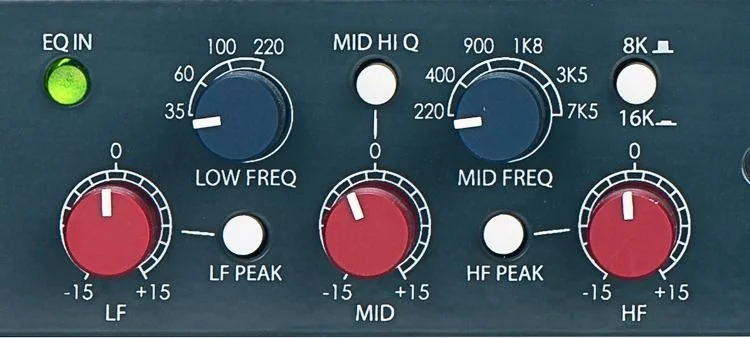
The best-of-the-classics inductor EQ
The Shelford Channel's EQ section is a 3-band, custom-tapped inductor circuit containing Rupert's favorite bands from his vintage equalizer designs. The low-frequency band is primarily based on the 1064 — acclaimed for its creamy, resonant bass. Unlike the 1064, though, the Channel gives you added dimension, punch, and control over your low end by letting you use the LF band as either a peaking or a shelving filter. The midrange band is based on the venerable 1073 and is perfect for sweetening instruments and vocals while nudging them forward in a mix. "Proportional Q" response also makes it ideal for attenuating problem frequencies. The high-frequency band is a hybrid design with the best of vintage and modern attributes. It should be noted that this EQ is in no way a clone; it's a decidedly modern design using components and techniques that simply did not exist in the 1970s — for instance, the use of capacitor-based topologies to achieve sonic richness and enhanced control.
- EQ In: engages all EQ frequency bands except HPF
- LF: adjusts up to 15dB of boost/cut at the selected low frequency
- Low Freq: 4-position rotary switch for selecting LF band corner or center frequency
- LF Peak: selects LF shelving (out) or peaking (in) mode
- Mid Hi Q: selects between a mid-band resonance of 2 (out) or 3.5 (in)
- Mid: adjusts up to 15dB of boost/cut at selected mid frequency
- Mid Freq: 6-position rotary switch selects center frequency of the midband EQ stage
- HF Peak: selects HF shelving (out) or peaking (in) mode
- 8K/16K: selects between an 8kHz (out) or 16kHz (in) center or corner frequency for HF band
- HF: adjusts up to 15dB of boost or cut at selected high frequency
The Super Diode-bridge Compressor
Like the Shelford Channel's inductor EQ and transformer-gain microphone preamp, the diode-bridge compressor/limiter is based on the topologies found in vintage Neve designs such as the 2254. It improves, however, on the early designs by the inclusion of full-wave rectification and a bevy of new control features. Although Rupert's vintage diode-bridge compressors were prized for their warm, punchy response, they were somewhat compromised by imprecise controls, attack-time inflexibility, low headroom, and high noise. The Shelford Channel's Super Diode-bridge Compressor delivers the attitude-packed, "in your face" sound of those classics, but with modern precision and flexibility — which makes it ideal on any source. Full Side-chain and stereo Link features are provided.
- Side Chain Insert Jacks (rear-panel): for fine tuning of compressor operation
- Comp In: engages the Channel's compressor-limiter section
- Threshold: sets level where the compressor "kicks in"
- Ratio: sets compression slope from 1.5:1 (minimal) to 8:1 (heavy)
- SC Insert: inserts rear-panel sidechain insert jacks into sidechain signal path
- HPF to S/C: routes highpass filter into the circuit that compressor uses to determine level
- Gain: for adding make-up gain to compensate for level attenuation lost to compression
- Timing: 6-position rotary adjusts attack/release speed of the compressor
- Link: links the sidechain control of multiple units for ganged or stereo operation
- Pre EQ: changes the order of compressor in the circuit chain
- Blend: mixes the dry and compressed signal for handy parallel compression
- Fast: speeds up both attack and release of the selected compressor time constant
Dual-tap transformer output
The Shelford Channel's output stage serves up the inimitable sound of Rupert Neve's classic designs while providing far more tonal versatility. The dual-tap output for the RN2042 square-core output transformer provides both high- and low-headroom outputs without compromising performance. The high-headroom tap takes advantage of the Shelford's higher-voltage design, delivering a pristine sound without non-linear output-stage coloration at high levels. The low-headroom tap, on the other hand, lets you drive the full voltage range of the Channel to accentuate this non-linear harmonic content — without clipping most pro interfaces. For vocals, drums, guitars, bass, and other instruments, this output lets you hit the transformer's sweet spot, which can inject life into a recorded performance in a way that other effects cannot.
The Silk and Texture controls
The Shelford Channel is packing a secret weapon the classics never had: its output transformer features the Silk Red/Blue and Texture controls from the Portico II Series that let you tailor the harmonic content and tonality of the output stage. By engaging these controls and sufficiently driving your output, you can dial in delectable 2nd- and 3rd-order harmonic distortion (that's the good kind) and saturation of the output transformer, imbuing your tracks with juicy rich thickness (think: 1073 on steroids) — with no danger of overloading the output stage. The Silk Red mode emphasizes harmonic content generated by the source's high frequencies; Blue mode, conversely, works off the low frequencies. The Texture knob controls the amount of added harmonic content. Disengage Silk, and your output is pristine and modern, while retaining Rupert's bigger-than-life transformer sonic signature.
The magical sound of Neve
Rupert Neve is an audio legend whose electronics designs defined the golden age of analog. Those of us at Sweetwater who have had the privilege of working on a Neve 8078 or its predecessors can attest to the fact that Neve's Series 80 consoles were indeed the pinnacle of hand-wired analog mixing desks. Mr. Neve has remained at the forefront of audio-circuit innovation for over half a century, and his current company, Rupert Neve Designs, continues to advance the state of the art with cutting-edge products that sound incredible and intelligently address the challenges of the digital age.
Rupert Neve Designs Shelford Channel Features:
- The definitive evolution of Rupert Neve's renowned 80 Series channel module technology
- A complete channel strip that delivers the essence of classic designs, along with modern versatility
- Input stage and transformer-gain mic pre
- Front-panel hi-Z direct input
- Best-of-the-classics inductor EQ
- Super Diode-bridge Compressor
- Dual-tap transformer output
- Silk and Texture controls
| Packed with ultra-fast, rock-solid performance, the Behringer S32 32-channel digital snake system bridges the gap between your band, your FOH engineer, and your audience. With the S32, you get 32 remote-controllable Midas-designed preamps and 16 analog, servo-balanced XLR returns at the stage end, and it's all piped through a single, convenient Cat 5e cable, thanks to integrated SuperMac technology from Klark Teknik. In other words: no more bulky analog snake! So step up to the digital age — order your Behringer S32 32-channel digital snake system from Sweetwater today!
AES50 networking capability provides compatibility with many digital mixers
When Behringer first developed their S32 digital snake system, they intended it to go hand-in-hand with their powerful X32 digital mixing system. But limiting such a convenient and affordable digital snake to the X32 alone would have been a shame, which is why Behringer designed it around the strict guidelines established by Klark Teknik. The result is an affordable digital snake that's completely compatible with any digital console that sports an AES50 digital Ethernet connection. So if you're running a Midas or Behringer digital mixing board, if it's got an AES50 Ethernet port on it, if you've got an S32 digital snake, you're never more than a single connection away from your stage box.
Remote-controllable preamps make setup fast, easy, and painless
Even if you try to get a jog in every day, no one likes having to run up to the stage every time you have to make an adjustment to your stage box. Thanks to the Behringer S32 digital snake system's remote-controllable preamp design, those back-and-forth cross-venue dashes are a thing of the past. Using the Klark Teknik SuperMAC protocol, your S32 will show up in your digital mixer's OS, giving you the control you need over your pres, right from the front of house position. And by the way, these preamps are the exact same high-quality Midas-designed preamps found in the X32 console, so you know you're getting quality sound with low noise and tons of headroom.
Total integration with Behringer's P-16 personal monitoring system
Streamlined, affordable, and super-easy-to-use, everyone's raving about Behringer's Powerplay P16 personal monitoring systems. When you add a Behringer S32 digital snake system to your PA rig, you're not just getting a great set of remote-controllable preamps and ditching tons of bulky cable, you're ready to add an advanced personal monitoring system directly inline with the rig you already have. That's because your S32 digital snake comes equipped with Ultranet connectivity, which provides your Powerplay P16-M monitor controllers with a digital split straight from the stage box.
Behringer S32 32-channel Digital Snake System Features:
- Simple, flexible, and affordable digital snake system that works with any AES50 network-ready digital console
- 32 x fully programmable and remote-controllable Midas-designed mic preamps give you exceptional sound, right from the stage
- 16 x analog, servo-balanced XLR outputs let you send complete monitor mixes to the stage
- AES50 network ports featuring Klark Teknik SuperMac technology, providing you with ultra-low latency digital audio that's in-ear compatible
- Up to 328' of networking capability via a single lightweight CAT-5e cable (not included)
- Dual AES50 ports let you cascade multiple S32 units, without a merger or a router
- Precise LED metering plus 7-segment displays let you keep a close eye on your levels
- Ultranet connectivity for Behringer's Powerplay P16 Personal Monitoring System is perfect for In-ear applications
- Dual ADAT outputs for use in splitter mode and stand-alone digital multicore applications
- MIDI In/Out for bi-directional communication between FOH console and on-stage MIDI devices
- USB connector for system updates via PC
- Planet Earth switching power supply for maximum flexibility, noise-free audio, superior transient response plus low power consumption for energy saving
- Durable yet compact, all-steel 3U rack-mount chassis provides flexible mounting
| Discover the PM7000N, the first Marantz fully discrete, current feedback integrated Hi-Fi amplifier with HEOS Built-in technology. The ideal choice for audiophiles that require Marantz musical sound and music streaming, the PM700N includes high-grade audio components, current feedback HDAMs, a toroidal transformer, and a high-speed instantaneous current power supply. The versatile PM7000N features multiple analog and digital inputs, and decodes digital audio files ALAC, FLAC and WAV lossless files up to 24-bit/192-kHz — plus, DSD 2.8MHz and 5.6MHz tracks for high-resolution listening. Stream your favorite music wirelessly, and control the amplifier with leading voice agents Apple Siri, Google Assistant, and Amazon Alexa.
Features
- Power to suit your audio preference: 2ch fully discrete current feedback integrated Hi-Fi amplifier; 60W per channel (8-ohm, 20Hz – 20kHz)
- Wide range of connectivity:
- Four analog inputs, one analog output, one coaxial input, two optical digital inputs and one USB-A for high-resolution audio files
- Marantz proprietary HDAM-SA3 circuit: Wider dynamic range with lower distortion for the output stage
- Flexibility for all configurations: Tone control to tune sound to your exact specifications and dedicated subwoofer output for evenly dispersed bass, no audible peaks or dips
- Newly designed electric volume circuit: Use the latest volume control IC to realize better channel separation, dynamic range, and distortion-reduction
- Play vinyl with exceptional clarity: Integrated phono input with newly designed FET input stage to improve signal purity and sound
- Premium Marantz SPKT-1+ speaker terminals: Improved connection to speakers
- Stream music from your favorite sources: Play songs from TuneIn, Internet Radio, Pandora, Spotify, SiriusXM, Amazon Prime Music, TIDAL and more via AirPlay 2, Bluetooth and the HEOS app (music streaming services may vary by region)
- Speak your commands: Supports Amazon Alexa, Google Assistant and Apple Siri voice agents for seamless voice control
- High-performance, high-resolution audio playback: Ability to decode high-resolution audio ALAC, FLAC and WAV lossless files up to 24-bit/192-kHz — plus, DSD 2.8MHz and 5.6MHz tracks for high-resolution listening
- Built-in Bluetooth and Wi-Fi with 2.4GHz/5GHz dual band support: Improved network stability even in Wi-Fi crowded homes
- Works with your TV remote: Program the PM7000N to work with your TV remote and easily adjust volume up, volume down, mute and source selection
Specifications
Inputs: RCA line x 3, RCA MM phono x 1, digital coax x 1, optical x 2, USB A x 1, Ethernet
Phono input sensitivity: 2 mV @ 47 kOhm
Phono SNR: 87 dB
Outputs: Tape out, subwoofer out, headphone out, speaker A and B
Power output (8 ohm / 4 ohm): 60 W / 80 W
Damping factor: 100 and over
Dimensions: 17.3" x 14.9" x 4.9"
Weight: 23.8 lb
| Rupert Neve Designs RNHP is a state-of-the-art headphone amplifier. Now when Mr. Neve turns his attention to anything, you know it's going to be good. And spectacularly so. What the RNHP delivers is reliable, reference-grade amplification for any pair of headphones. Based on the headphone amp in the RND 5060 Centerpiece, the dedicated 24-volt design is spec'd with calibrated +4dBu Line, RCA, and 1/8" stereo inputs. Everything's housed in a road-tough, VESA-mountable steel chassis. The unit's effortless sonic performance and the ability to drive virtually any 'phones without compromise let you perform, mix, and savor your music with stunning clarity.
Rupert Neve Designs RNHP at a Glance:
- Unerring accuracy for better performances
- The benefits of near-zero-ohm output impedance
Unerring accuracy for better performances
You know you perform your best when your cans sound great - and that's where the RNHP can make a huge difference. Many integrated headphone amps are plagued with a non-linear frequency response, as well as noise, distortion, and skimpy headroom. To some, these units' lackluster sonic performance may seem "close enough for rock 'n' roll," however at Sweetwater, we believe there is the performer's subconscious response to consider. After all, if you're not inspired by what you're hearing, your performance will suffer.
The benefits of near-zero-ohm output impedance
Rupert Neve Designs spec'd the RNHP with near-zero-ohm output impedance to minimize frequency-based reactive-load impedance shifts - a problem unique to headphone monitoring. This ensures accurate sound reproduction, which is obviously important if you need to trust the decisions you make with headphones. You'll find the RNHP's unerring accuracy beneficial when you're using just one set of cans, and also when you're comparing a mix on multiple pairs of headphones.
Rupert Neve Designs RNHP Features:
- Reliable, reference-grade amplification for any pair of headphones
- Based on the headphone amp in the RND 5060 Centerpiece
- Effortless sonic performance
- The ability to drive virtually any headphones
- Dedicated 24-volt design
- Calibrated +4dBu Line, RCA, and 1/8" stereo inputs
- Near-zero-ohm output impedance minimizes frequency-based reactive-load impedance shifts
- Road-tough, VESA-mountable steel chassis
| Now in its second generation, the ISA 428 Mk II incorporates four of Focusrite's renowned mic pres in a simple-to-operate 2U enclosure, placing four mic preamps, instrument inputs and line ins at your fingertips. The original Focusrite mic pre was designed to suit the microphones of the time; today's model makes one small change, adding three additional input impedances to the classic ISA110 setting, allowing you to match any microphone, old or new, and access a wide range of sounds, from the character and warmth of a vintage mic to the clear transparency of a modern design. Or you can experiment and bring out just the qualities you want.In addition to the mic inputs, there are four front-panel instrument inputs making the ISA428 Mk II ideal for overdubs in the control room with no need for a DI box. On the back: four line inputs and switchable insert points on each channel to allow routing via external signal processors. There's also a versatile, vintage design variable high-pass filter to control what's going on at the bass end. And finally… accurate, 6-LED meters to tell you exactly what's going down. Optionally available for the ISA428 Mk II is a precision eight-channel A-D converter with 122dB dynamic range and superb jitter performance – ideal for simple interfacing with your DAW.
Four ISA series transformer-based preamps
ISA series mic preamps have been the producers' choice on countless hit records over the last two decades.
Eight-channel optional A-D converter
Four additional A-D converter inputs allow eight channels of high quality conversion, with a dynamic range of 122dB and jitter performance below 250 picoseconds.
Selectable impedance
Ideal for mic matching or extended microphone creativity. Settings include the 'Vintage ISA110' setting, providing the original focusrite signature sound.
Four front panel instrument inputs
Instant access on the front fascia - no separate DI box required.
Dedicated analogue insert points
Switchable insert points are featured on every channel, allowing routing (between preamp and output) through additional external processing.
Accurate LED meters for every channel
Clear metering designed to catch even the fastest and most elusive of transients.
Mic Inputs
- Frequency response at minimum gain (0dB): -0.35dB at 20Hz and –3dB at 122kHz
- Frequency response at maximum gain (60dB): –2.5dB at 20Hz and –3dB 103kHz
- Gain range: 0dB to +60dB in 10dB steps, plus 0dB to +20dB continuously variable trim
- Maximum headroom: +7.4dBu
- THD+N: 0.0009% (measured at 1kHz -20dBu input signal, at 30dB gain setting, with a 20Hz/22kHz bandpass filter)
- Noise EIN: -126dB (measured at 60dB of gain with 150Ω termination and 20Hz/22kHz bandpass filter)
- Noise at main output with unity gain: -98dBu (measured with a 20Hz/22kHz bandpass filter)
- SNR: 123dB (relative to max output 25dBu)
- SNR: 120dB (relative to 0dBFS (+22dBu)
- CMRR: 88dB.
- Input Impedance, variable: 600Ω, 1400Ω, 2400Ω, 6800Ω
Line Inputs
- Frequency Response at unity gain (0dB): -0.3dB at 20Hz and –3dB at 94kHz
- Gain range: -20dB to +10dB in 10dB steps, plus 0dB to +20dB continuously variable trim
- Maximum headroom: +25.4dBu
- THD+N: 0.002% (measured with +4dBu input signal, 0dB gain setting, with a 20Hz/22kHz bandpass filter)
- Noise at main output with unity gain: -91dBu (measured with a 20Hz/22kHz bandpass filter)
- SNR: 116dB (relative to max output 25dBu)
- SNR: 113dB (relative to 0dBFS +22dBu). Input Impedance: 10kΩ
Instrument Inputs
- Frequency Response at +10dB gain: -0.2dB at 20Hz and 0dB at 200kHz
- Frequency Response at +40dB gain: -3dB at 20Hz and –3dB at 38.4kHz
- Gain range: +10dB to +40dB continuously variable
- Maximum headroom: +11.5dBu
- THD+N: 0.006% (measured with –20dBu input signal, at minimum gain (+10dB), with a 20Hz/22kHz bandpass filter)
- Noise at main output with minimum gain (+10dB): -95dBu (measured with a 20Hz/22kHz bandpass filter)
- Input Impedance = >1MΩ
High Pass Filter
- Roll off = 18dB per octave 3 pole filter
- Frequency range: 16Hz to 420Hz (continuously variable, measured at the 3dB down point)
Meters
- 6 LED meter is calibrated 0dBFS = +22dBu (the maximum level which can be correctly converted by the optional internal A/D converter before overload occurs). The meter calibration points are as follows:
- Meter panel calibration value in dBFS / Equivalent dBu value
- 0dBFS / +22dBu
- -2dBFS / +20dBu
- -6dBFS / +16dBu
- -12dBFS / +10dBu
- -18dBFS / +4dBu
- -42dBFS / -20dBu
Analogue Channel Inputs (Inputs 1-4)
- 4 instrument 1⁄4" TS jack inputs on front panel
- 4 microphone XLR inputs on rear panel
- 4 line 1⁄4" TRS jacks on rear panel
- 4 insert return 1⁄4" TRS jacks on rear panel
- 4 ADC XLR inputs on rear panel
Analogue Audio Outputs (Outputs 1-4)
- 4 line XLR outputs on rear panel
- 4 insert send 1⁄4" TRS jacks on rear panel
Other I/O
- IEC power input connector 100Vac – 240Vac
Front Panel Indicators
- 8 output meters, 6 segment
- 4 30-60 mic gain range selection indicator
- 4 +48V phantom power indicator
- 4 Phase indicator
- 4 Insert In indicator
- 4 Filter In indicator
- 4 Input selection indicators (Mic, Line, Inst)
- 4 Z In microphone input impedance selection indicators (Low, ISA110, Med, High) Clock select indicators (44.1, 48, 88.2, 96, 176.4, 192)
- Ext clock indicators (Lock, Word clock, 256X)
Weight
Dimensions (W x H x D)
- 480mm (W) x 88mm (H) x 280mm (D)
- 19" (W) x 3.5" (H) x 11" (D)
| The Shelford Channel is built around Rupert Neve’s first new transformer-gain, class-A microphone preamplifier in over 40 years, a “best-of-the-classics” inductor EQ section, a tone-packed diode bridge compressor, the power of variable Silk saturation, a new dual-tap transformer output stage, and twice the operating voltage of vintage designs.
The Input Stage and Transformer Gain Mic Pre
Like Rupert’s designs from his time in Little Shelford , the Shelford Channel’s preamplifier uses a directly-coupled transformer input with gain provided by the custom transformer itself – a first in over 40 years for Rupert Neve. This new custom-designed input transformer, along with its careful integration with the surrounding class-A circuitry, is critical to the Channel’s bold and instantly recognizable character.
Conveniently, the Direct Input uses the same topology as the best-selling RNDI Active Transformer Direct Interface, providing astonishing clarity for high-Z instrument signals, with unparalleled low-frequency response and an incredibly smooth high end.
What is Silk?
The Silk & Texture circuit on the Shelford Channel allows you to fine-tune the amount (and type) of harmonic content in the output stage. This means your signal can be adjusted from quite transparent to settings that produce nearly 10x the amount of sonic color as Rupert’s vintage modules – and in two very unique modes. No matter what sound you’re looking for, Silk can help get you there.
The Dual Tap Transformer Output
Complementing the Silk circuit is the custom-designed output transformer, which uses Rupert Neve Designs’ unique dual-tap output topology. This offers both full-headroom (+26dBu) and -6dB outputs, allowing the engineer to drive the unit fully into classic transformer saturation without clipping converters and other devices later in the chain.
The “Best-Of” EQ
The Shelford Channel’s 3-band, custom-tapped inductor EQ was inspired by our favorite elements of Rupert’s vintage EQ designs. The low frequency band is designed to produce a creamy, resonant bass response similar to a vintage 1064 – but unlike the vintage modules, the LF band on the Shelford Channel can be used as either a shelf or a peak filter, adding punch, dimension, and control to your low end.
The midrange band is based on that of the 1073, ideal for sweetening vocals and instruments while bringing them forward in a mix, and its proportional “Q” response makes it well-suited for minimizing problematic frequencies. The high frequency band is a hybrid vintage / modern design, blending inductor circuitry with capacitor-based topologies to achieve vintage tones with enhanced control, with the shelf / peak corner switchable between 8K or 16K.
The Diode Bridge Compressor
Like the Inductor EQ and Transformer Gain microphone preamp, the Diode Bridge Compressor in the Shelford Channel is based on the same topologies found in Rupert’s vintage designs – but refined & adapted for the modern engineer.
What is diode bridge compression? Where the VCA compressor found in the Master Buss Processor provides unmatched clarity, the weighty, harmonically rich tonality of diode bridge compression can be essential in pushing key sources like vocals, electric guitars, bass and drums to the forefront of a mix.
By understanding the limitations of vintage units like the legendary 2254, painstaking effort was taken to reproduce the unique tone of these classics while improving the noise floor & accuracy, expanding inflexible time constants, adding full wave sidechain detection for improved dynamic response, and widening the range of threshold and ratio controls.
Delivering the powerful sound of these iconic designs with enhanced flexibility for the modern age, the Shelford’s diode bridge compressor is a dynamic tool equipped to make a statement on virtually any mix or track.
MIC PREAMP
INPUT IMPEDANCE
2200 Ohm
MAXIMUM INPUT
- +21.5 dBu from 150 Hz to 22 kHz
- +8 dBu 20 Hz to 22 kHz
NOISE
- Un-weighted, 22 Hz-22 kHz, source impedance 150 Ohm balanced.
- Main Out @ unity gain -100.9 dBu
- -6 dB Out @ unity gain -106.6 dBu
- +30 dB gain (Main Out) -91.37 dBu
- +66 dB Gain (Main Out) -64.1 dBu
- Equivalent Input Noise -121.37 dBu
FREQUENCY RESPONSE
+/-0.25 dB from 17 Hz to 45 kHz
DIRECT INPUT
MAXIMUM INPUT
8 dBu @ 20 Hz to 120 kHz
NOISE (MAIN OUTPUT)
-100 dBu (22 Hz to 22 kHz)
LINE INPUT
MAXIMUM INPUT LEVEL
+30.5 dBu 20 Hz to 30 kHz
TOTAL HARMONIC DISTORTION AND NOISE
- @ 1 kHz, +20 dBu output level, no load: Better than 0.002%
- @ 20 Hz, +20 dBu output level, no load: 0.05% Typical (2nd and 3rd harmonic)
NOISE (MAIN OUTPUT)
Un-weighted, 22 Hz - 22 kHz, source impedance 40 Ohm balanced, no load.
-101.1 dBu
FREQUENCY RESPONSE
+/- 0.25 dBu from less than 10 Hz to 110 kHz
-0.32 dB @ 120 kHz
MAXIMUM OUTPUT LEVEL
+26 dBu @ 16 Hz to 20 kHz
TOTAL HARMONIC DISTORTION AND NOISE WITH SILK ENGAGED
RED
- MIN TEXTURE @ 100 Hz, +20 dBu input level, no load: 0.0131%, mostly 3rd harmonic (typical)
- MAX TEXTURE @ 100 Hz, +20 dBu input level, no load: 1.66%, mostly 2rd harmonic (typical)
BLUE
- MIN TEXTURE @ 100Hz, +20 dBu input level, no load: 0.0079%, mostly 3rd harmonic (typical)
- MAX TEXTURE @ 100Hz, +20 dBu input level, no load: 0.941%, mostly 2rd harmonic (typical)
HIGH PASS FILTER
- Continuously variable swept frequency from 20 Hz to 250 Hz.
- Slope: 12 dB/Octave
EQ NOISE
Un-weighted, 22 Hz-22 kHz: -92 dBu
SIGNAL PRESENT
Illuminates GREEN when input stage signal level reaches -20 dBu
OVERLOAD INDICATOR
Illuminates RED when input stage signal level reaches -23 dBu
DIODE BRIDGE COMPRESSOR
- NOISE (BW 22 Hz – 22 kHz)
- 0 dB Makeup Gain: -84.5 dBu
- +20 dB Makeup Gain: -64.2 dBu
TIME CONSTANTS
- Measurements taken represent full range achievable between 1.5:1 Ratio and 8:1 Ratio setting.
- 0 dBu I/P 1kHz Burst Tone used for all recorded measurements.
- Fast (TC1): Attack 180µS — 1.8mS // Release 100mS – 150mS
- MedFast (TC2): Attack 750µS – 5.25mS // Release 160mS – 250mS
- Med (TC3): 2.7mS – 18mS // Release 350mS – 525mS
- MedSlow (TC4): 4.6mS – 38mS // Release 600mS – 1 S
- Slow (TC5): 11mS – 72.5mS // Release 800mS – 1.25 S
- Auto (TC6): 5.75mS – 35.5mS // Release T1 400mS – 850mS, T2 TBD
- “Fast” Mode Multiplier: Modifies aforementioned TC’s by 70% of original value
PRODUCT DIMENSIONS
19” (48.3 cm) x 10.5” (26.7 cm) x 1.75” (4.4 cm) |


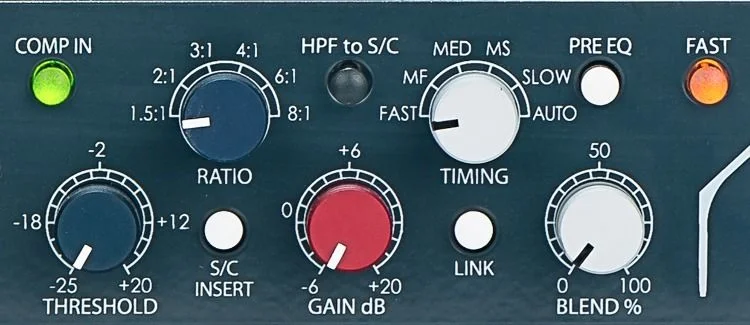




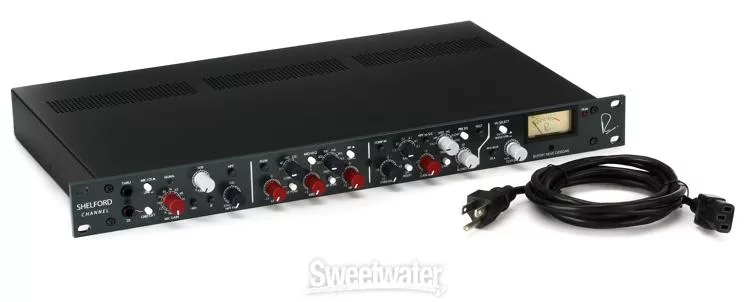









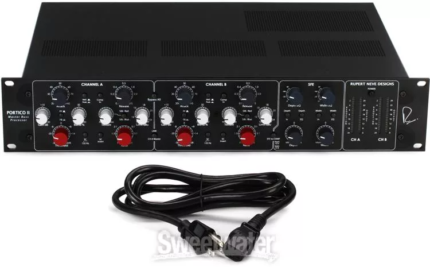

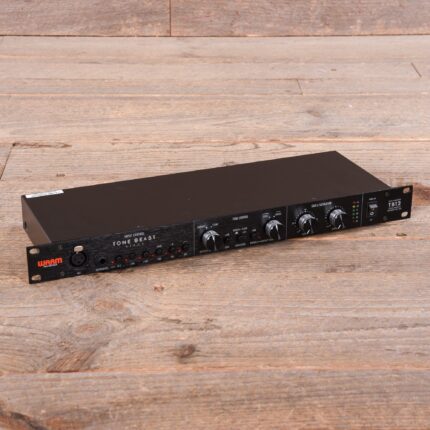
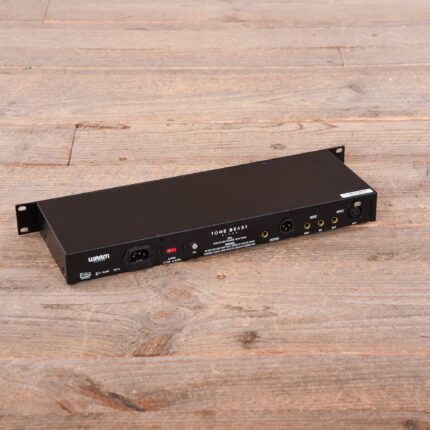





Reviews
There are no reviews yet.